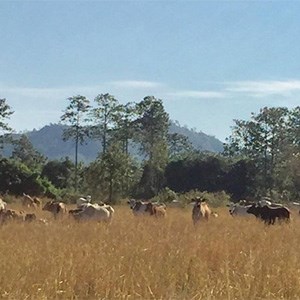Contact
Department of Applied Animal Science and Welfare

This thesis explored smallholder cattle production in Cambodia and investigated the nutritive value of groundnut foliage and/or cassava tops as protein supplementation for cattle production.
Cambodia is divided into four agro-ecological zones (AEZs): The Great Lake floodplain, the Mekong floodplain, the Coastal zone and the Plateau/Mountainous zone. There are two basic forms of cattle production in Cambodia, lowland and upland production systems, and both are constrained by feed shortages. In lowland areas, the land is dominated by rice crops, which imposes significant constraints on the supply of feed for animals. Although there is more land available in upland areas, most of this land is not accessible for cattle production, since the government has ceded it to private companies for development. The severity of animal feed shortages varies between AEZs, but poor animal nutrition is a general problem. Poor nutrition contributes to a higher incidence of cattle diseases and higher parasite burdens.
The majority of households surveyed in this thesis kept 1-3 cattle and the most common cattle management system was grazing with supplementation. There was shortages in feed resources particularly during the dry season, when mainly rice straw and low quality natural pasture were available. The major constraint to cattle production in the agro-ecological zones of the Great Lake floodplain, Mekong floodplain and Coastal zone was found to be low breed quality, while diseases were identified as the main constraint in the Plateau/Mountainous zone.
Foliage from groundnut, left as crop residues, was examined for its potential as a protein supplement to a basal diet of rice straw and para grass for growing cattle. Increased levels of sun-dried groundnut foliage (DGF) improved total dry matter intake, crude protein digestibility and nitrogen retention in cattle. Daily weight gain was higher on the supplemented diets than on the control diet, but did not differ among levels of supplementation. Supplementation of DGF at levels of 2 or 3 g crude protein per kg body weight increased microbial protein production and the efficiency in microbial crude protein production in cattle.
Responses in rumen fermentation characteristics were investigated in adult cattle using dried cassava tops (DCT) alone or in combination with DGF as a protein supplement to a basal diet of rice straw and para grass. Total dry matter intake increased when animals received diets containing DGF or DGF combined with DCT. However, the diet containing DCT had the lowest digestibility of crude protein and neutral detergent fibre. The ruminal ammonia nitrogen and total volatile fatty acid response increased with all diets containing supplements.
 Contact:
Contact:
Pok, Samkol
psamkol@celagrid.org